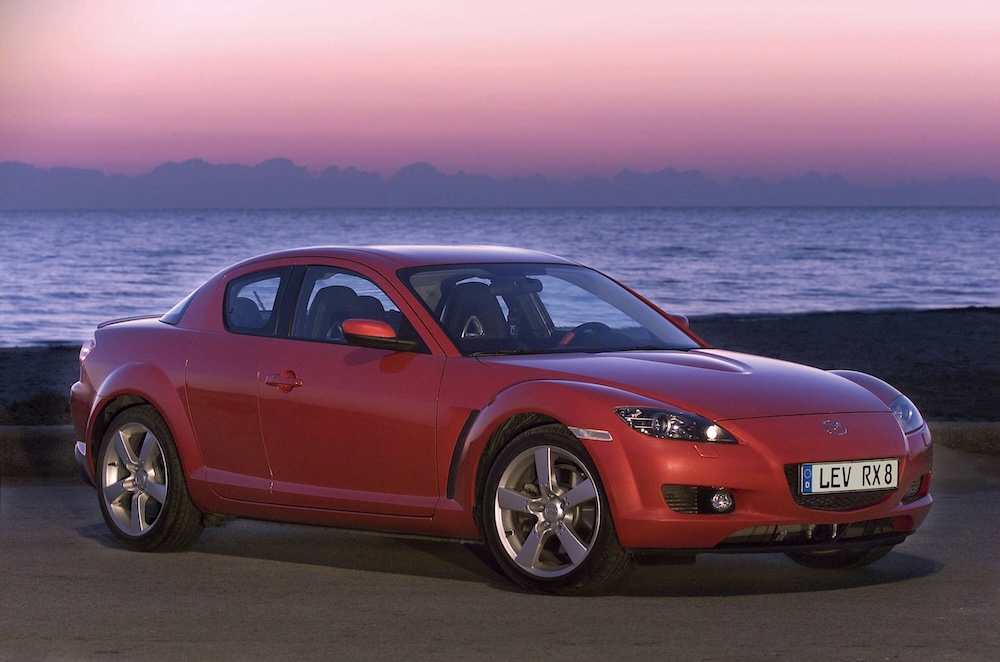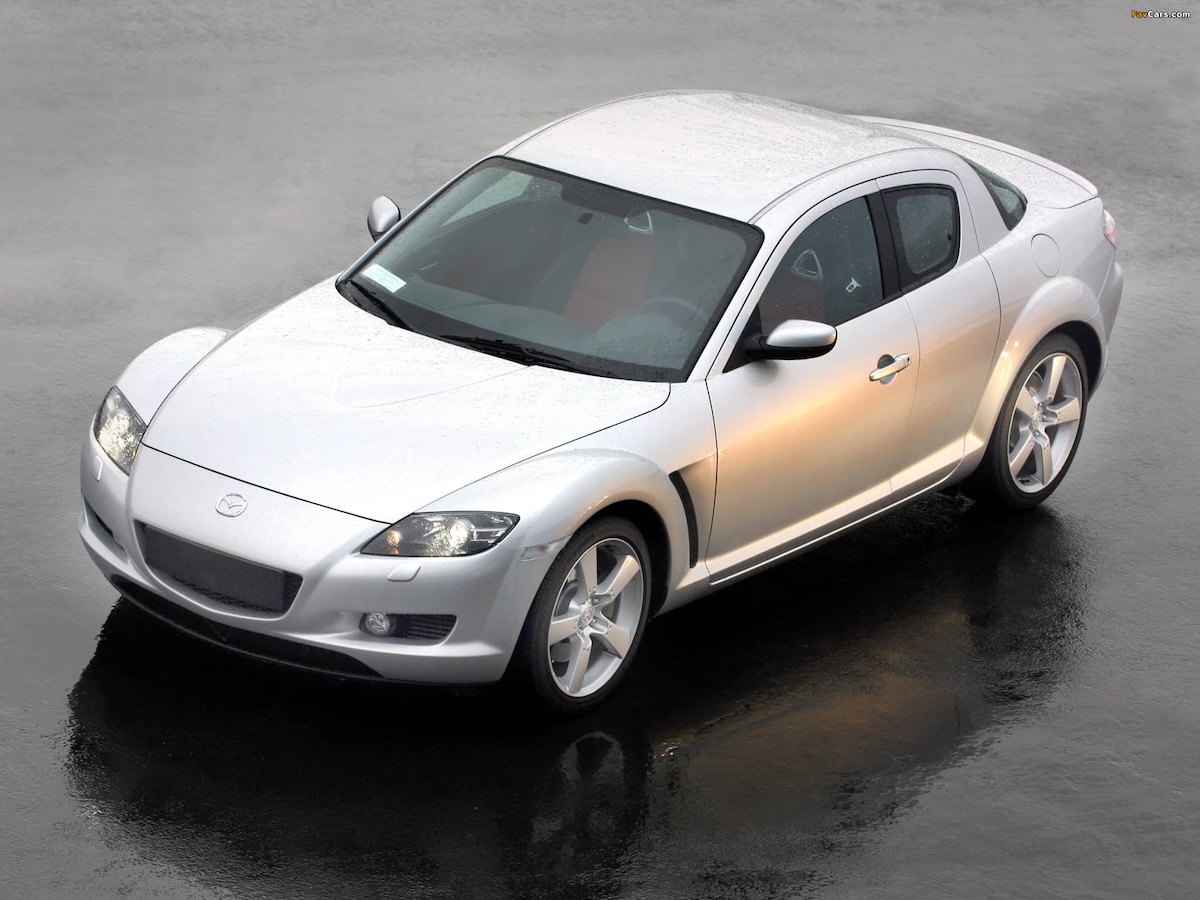Few cars from the early 2000s evoke such a strong emotional connection as the last rotary-powered Mazda. Decade transitions rarely land on a neat calendar date. They’re shaped by world events, technological advancements and memorable happenings. It’s similar in the car world and the Mazda RX-8 played a significant role. It signalled the end of one era – the ending of the rotary engine and the beginning of a new chapter for Mazda as a respected builder of sporty, driver-focused cars.
For me personally, the RX-8 always reminds me of one thing – Jeremy Clarkson sliding it sideways on the Dunsfold track while claiming that rotary powered sports car is the best car he’s driven that year. Quite big words.
An Ambitious Mission
The RX-8 was Mazda’s attempt to combine the spirit of its RX-7 and Cosmo models into a single, sporty-yet-practical coupe. With help from Ford, Mazda entered the new millennium with a bunch of new cars– the Mazda2, Mazda6, and of course, the RX-8. I’m lucky enough to have had a ride in a pristine example of an RX-8. It was a 40th Anniversary Edition with unique 18-inch wheels (later used on the facelift), special badges, a subtle rear spoiler, and factory Bilstein dampers with extra front-end bracing. Depending on the market, it came in exclusive colour combos. The one I sat in was finished in Metropolitan Grey Mica over a Cosmo Red leather interior.
Unique Rotary Powertrain
The first thing you notice with these cars is, surprisingly, how quiet the engine is. It hums along at low RPMs like it's made out of butter and is the main party piece of the RX-8. The RENESIS 13B-MSP rotary engine has two rotors, six ports, and 212 horsepower, which varied depending on the market it was sold. Interestingly, under the hood, the plastic engine cover also hides the body brace that adds rigidity. The engine itself, a tiny 1.3 litre hamster sits deep in the bay, so compact it seems you could fit another one beside it.
Pros and Cons
Inside, the RX-8 is surprisingly roomy – you can slip into the back seats without much fuss, and there's plenty of soft leather and smart storage. But not everything impresses. The heated seat buttons feel like something stolen from a parts bin for old trucks. It’s grey, square and awkwardly plonked in the middle of the centre console. Close the rear-hinged back doors and the side of the body flexes like Chinese cars did 20 years ago (and to be honest, even today). And then there's fuel consumption – the RENESIS unit drinks petrol as if it was an American V8. If only it the reliability was of that as well.
It’s no secret that the RX-8 struggled in the market. Lots of small and big issues added up. The engine is very temperature-sensitive. It hates being shut down cold or hot. You need to check the oil often and do it carefully, because the dipstick sits dangerously close to a scorching exhaust manifold. And the concept of the car itself didn’t help as it was quite confusing: a sporty, exotic coupe with four doors and a stretched body to make room for four seats.
It’s All About the Rev Range
The RX-8 isn’t about torque. It only offers 216 Nm, so just slightly more than your usual 3-cylinder micro city car, but it loves to rev, and with each rising RPM, the car gains speed smoothly and confidently. The idle is shaky, certainly shakier than your average German car, but once it’s spinning, the engine becomes smooth and linear, except for the sound, which remains pleasantly buzzy like a beehive and makes you feel like the car is thrilled to be alive.
The car redeems itself on the road too. The sound is the first thing that hits you. You might have heard it in videos or on TV, but nothing prepares you for how it enters your ears in real life. From behind the wheel, the rotary's buzz feels like it's coming from the vents or being pumped through the speakers. That’s because the engine is mounted so close to the firewall that there’s barely any insulation between it and the cabin. It becomes the emotional centre of the driving experience. The handling is sharp and communicative. The RX-8 has 50/50 weight distribution, and the engine and fuel tank are tucked near the centre of the car. That small engine low torque means it won’t spit you into a ditch if you’re too eager with the throttle.
Not a Hit, But a Future Classic
Unfortunately, the public didn’t quite fall in love with it. Mazda built its last rotary engine on June 21, 2012. RX-8 production also ended and it left the European market in 2010, unable to meet tightening CO₂ regulations. Mazda did start producing a rotary engine in 2023, but it’s far from what some enthusiasts want as it is only built to work as a generator in the electric MX-30 crossover. But there is no such thing as a car without a fan. Even the most difficult machines have their loyal owners who refuse to let go. The Mazda RX-8 proves that even with bad reliability and difficult maintenance, its dynamics and uniqueness can win over the right kind of driver, who isn’t looking for perfection, but mechanical connection.
---
Embárcate en un viaje para encontrar tu vehículo ideal navegando por nuestras Categorías de Coches. O adéntrate en nuestra tienda Classic Passion Shop para encontrar una emocionante gama de productos de nuestros socios, ¡perfecta para los entusiastas que buscan mejorar su colección!














